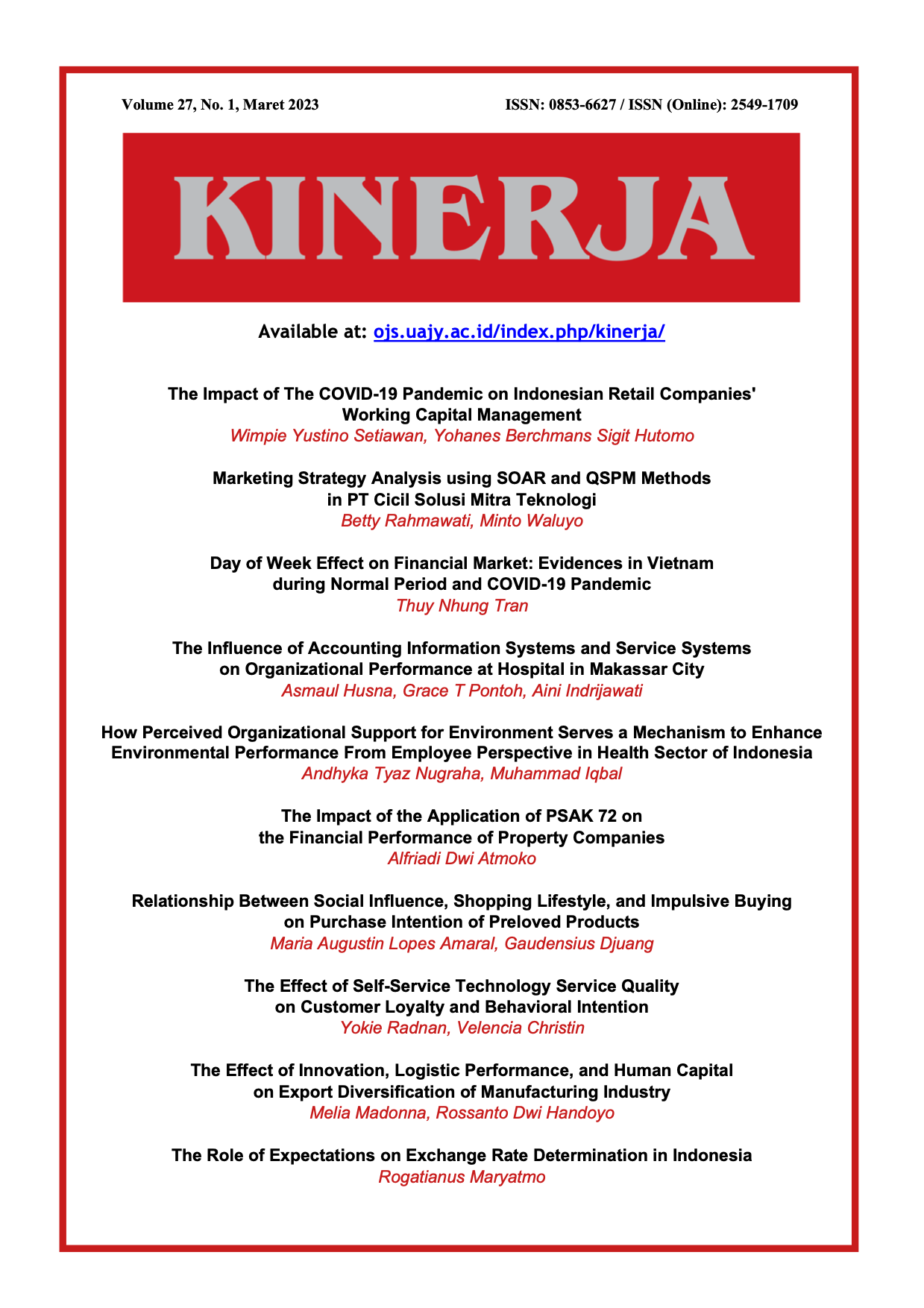The Role of Expectations on Exchange Rate Determination in Indonesia
DOI:
https://doi.org/10.24002/kinerja.v27i1.6926Keywords:
rational expectation, expectation formation, exchange rate, interest differentialAbstract
There are two purposes of this paper. Firstly, it deals with expectation formation. Secondly, it will be tested whether the expectation has a significant role in determining the current exchange rate in the case of Indonesian currency against the US dollar and Euro. This research will compare two kinds of expectation formation. Firstly, the expectation built from the fundamental economy is known as rational expectation formation. Secondly, the expectation formulated from past time series information, the Auto Regressive Moving Average (ARMA) model, is utilized. The steps to prove the role of expectation are stationary process, degree of integration, co-integration, and U-Theil's Inequality Coefficient Test (UTIC). It is found that both kinds of expectation formation have essential roles in determining the current exchange rate in Indonesia. However, according to UTIC criteria, a rational expectation better explains both current exchange rate movements.
References
Arlt, J. and Mandel, M., 2017. An empirical analysis of relationships of forward exchange rates and present and future spot exchange rates: Example of CZK/USD and CZK/EUR. Finance a Uver - Czech Journal of Economics and Finance, 67(3), pp. 199–220.
Bhargava, V., Dania, A. and Malhotra, D.K., 2011. Covered interest rate parity among BRIC nations. The Journal of Business and Economic Studies, 17(1), p.37-81.
Bank Indonesia, 2018. Statistik Ekonomi dan Keuangan Indonesia. Available at: http://bi.go.id/statistik/statistik keuangan/statistik ekonomi dan keuangan Indonesia/SEKI.
Chacoliades, M., 1990. International Economics. Internatio. Singapore: McGraw-Hill Publishing Company.
Chiang, C. A. and Wainwright, K., 2005. Fundamental Methods of Mathematical Economics. 4th ed. New York: McGraw-Hill.
Da Costa, C. E., Issler, J. V. and Matos, P. F., 2015. A note on the forward and the equity premuim puzzles: Two symptoms of the same illness?. Macroeconomic Dynamics, 19(2), pp. 446–464. doi: 10.1017/S1365100513000400.
Echavarria, J. J. and Villamizar-Villegas, M., 2016. Great expectations? evidence from Colombia’s exchange rate survey. Latin American Economic Review. Springer Berlin Heidelberg, 25(1), pp. 1–27. doi: 10.1007/s40503-016-0033-2.
Engel, C., 1999. On the Foreign Exchange Risk Premium in Sticky-Price General Equilibrium Models. International Tax and Public Finance, 6, pp. 491–505.
Engle, R. F. and Granger, C. W. J., 1992. Long Run Economic Relationships:Readings in Co-integration. New York: Oxford University Press.
Fama, E. F., 1984. Forward and Spot Exchange Rates. Journal of Monetary Economics, 14.
Gujarati, D. N. and Porter, D. C., 2009. Basic Econometrics. 9th ed. Singapore: McGraw-Hill.
Hamzaoui, N. and Regaieg, B., 2016. Exploration of the foreign exchange forward premiums and the spot exchange return: A multivariate approach. International Journal of Economics and Financial Issues, 6(2), pp. 694–702.
Harvey, J. T., 2006. Modelling Interest Rate Parity: A System Dynamics Approach. Journal of Economic Issues, XL(2), pp. 395–403. Available at: http://dx.doi.org/10.1016/j.jaci.2012.05.050.
Harvey, J. T. and Quinn, S. F., 1997. Expectations and rational expectations in the foreign exchange market. Journal of Economic Issues, 31(2), pp. 615–622. doi: 10.1080/00213624.1997.11505953.
Hill, R. C., Griffiths, W. E. and Lim, G. C., 2008. Principles of Econometrics. 3rd ed. New York: Willey and Son.
Holden, K., Peel, D. A. and Thompsons, J. L., 1985. Expectations: Theory and Evidence. New York: St.Matin’Es Press.
Ishioro, B. O., 2014. The dynamics of exchange rate expectations formation: The Nigerian perspective’, Ekonomska Misao I Praksa-Economic Thought and Practice, 23(2), pp. 431–460.
Jafari, Y., Ismail, M. A. and Kouhestani, M. S., 2011. Determinants of trade flows among D8 countries: Evidence from the gravity model. Journal of Economic Cooperation and Development, 32(3), pp. 21–38.
Kallianiotis, I., 2017. Exchange Rate Movement: Efficiency in the Foreign Exchange Market. International Research Journal of Applied Finance, VIII(4), pp. 429–443.
Kallianiotis, I., 2018. Exchange rate expectations. Journal of Applied Finance & Banking, 2(2018), pp. 101–134.
Kozul, I., 2013. Co-integration analysis of purchasing power parity in Republic of Croatia. UTMS Journal of Economics, 4(3), pp. 253–268.
Krasker, W. S., 1980. The “peso problem” in testing the efficiency of forward exchange markets. Journal of Monetary Economics, 6(2), pp. 269–276. doi: 10.1016/0304-3932(80)90031-8.
Leitner, J. and Schmidt, R., 2007. Expectation formation in an experimental foreign exchange market. Central European Journal of Operations Research, 15(2), pp. 167–184. doi: 10.1007/s10100-007-0024-0.
Maitra, B., 2016. Monetary, real shocks, and exchange rates variations in India. Journal of Economic Development, 41(1).
Maryatmo, R., 2005. Dampak Moneter Kebijakan Defisit Anggaran Pemerintah dan Asa nalar Dalam Simulasi Model Makro-Ekonomi Indonesia. Yogyakarta: Penerbit Universitas Atma Jaya Yogyakarta.
Miah, F., Hassan, M. K. and Alam, S. M. I., 2004. Testing the rationality of exchange rate expectation: Evidence from survey data. American Business Review, 22(1), pp. 11–20.
Moon, S., 2018. Foreign exchange return predictability: Rational expectations risk premium vs. expectational errors. SSRN Electronic Journal, 22(4), pp. 467–505. doi: 10.2139/ssrn.3309048.
Perry, W. and Juhro, S. M., 2016. Kebijakan Bank Sentral Teory dan Praktek. Jakarta: PT Raja Grafindo Persaja.
Pindyck, R. S. and Rubinfeld, D., 1991. Econometric Models and Economic Forcasting. 3rd ed. New York: McGraw Hill.
Shareef, H. and Shijin, S., 2016. Expectations hypothesis and term structure of interest rates: An evidence from emerging market. Asia-Pacific Financial Markets. Springer Japan, 23(2), pp. 137–152. doi: 10.1007/s10690-016-9212-z.
Tasseven, Z., 2017. Bubbles in the Middle East stock markets. International Journal of Economic Perspective, 11(3), pp. 304–314.
Tfaily, A., 2018. Economic fundamentals over long and short horizons. Review of International Comparative Management, 19(2), pp. 167–174. doi: 10.24818/rmci.2018.2.167.
Throop, A. W., 1993. A generalized uncovered interest parity model of exchange rates. Economic Review, 2, pp. 3–16.
Wickremasinghe, G.B., 2016. Efficiency of foreign exchange market of Sri Lanka: some empirical evidence. Economics, Management, and Financial Markets, 11(4), pp.49-60.















